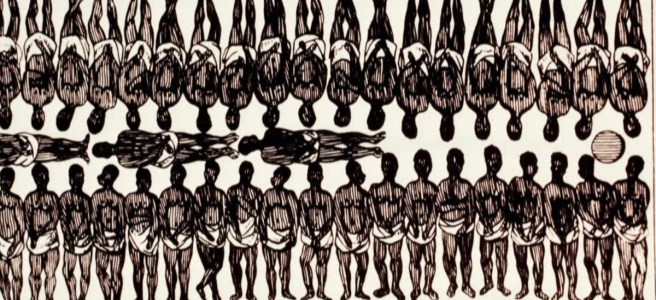I have just been reading my good friend Tommy Sheridan’s impassioned condemnation of slavery and racism. As ever, I have questions. I always have questions. Certain of these questions are perennial. Questions such as: Where does it end? Where is the line to be drawn? Who decides?
Of actions I ask: Why? For what purpose? What is the intent? What does the action hope to achieve? What are its likely effects?
If statues, why not buildings? If we are to destroy statues because they memorialise those who built massive fortunes on a foundation of unimaginable human misery then what about the buildings which memorialise those same people? Where is the line to be drawn? Where does it end? Who decides?
Is it wise to leave such decisions to the mob? Is it not characteristic of mobs that they are notoriously poor at imposing limits? Is it smart to have the criteria by which things are selected for destruction set by those most driven by the basest urges? Is it sensible to have the scale of destruction limited only by the human capacity for destructiveness?
What is the purpose of destroying statues honouring plainly dishonourable men? Is it to make a statement to the effect that we do not honour them? In which case, how can we in good conscience continue to enjoy the benefits of other products of slave-traders’ philanthropy – or troubled consciences? Do we not honour these men more by using the schools, libraries, museums etc. donated by them in the hope of immortality or constructed in their memory by those who sought a portion of that immortality – or to profit from said construction?
If destroying statues of those whose immense wealth derived from savage exploitation of human beings is a gesture protesting racism rather than or as much as a gesture protesting slavery, then what is the deeper purpose? Setting aside the atavistic self-indulgence which doubtless drove at least a few of that Bristol mob, what was the intent of the protesters? What did they hope to achieve by their action? What is their ultimate aim?
Do they hope to eradicate racism? Is that not a forlorn hope? Is not the capacity for irrational hate as much a part of human nature as the equally unreasoning if much less lamentable capacity for love?
Is it their purpose to address the myriad social ills which flow from the expression of racism? Do they hope to eliminate racism made manifest as in the killing of young black men by white authority? In which case, what is the connection between the two – the destruction of a statue and the manifestation of racism? In what way does the former impact the latter?
Few would deny that the intention is worthy – and those few are themselves unworthy – but is the action effective? Does it serve a worthy purpose? Might there be some good that flows from the protest much as ill flows from that which is being protested?
Others may have questions of their own. Some may have questions for me. In response to the foregoing some might demand to know what I have done to combat racism. I would reply simply that I have not committed any racist acts. I did not commit any racist acts yesterday. I have no racist acts planned for today. And if things proceed according to habit and custom, I shall commit no racist acts tomorrow.
Thus have I combated racism. In this way I shall continue to combat racism. By being aware of the capacity for racism that is in me, and keeping it there – where it belongs. By acknowledging that this capacity for racism is part of my evolutionary inheritance. By knowing that it need not be part of the person that is me. By choosing not to allow that latent racism any space in my conscious self.
Humanity is not divided into racists and non-racists. The divide is between potential racists and those who have realised that potential. Between those who recognise that racism is out of place in civilised society and those who suppose that because it is part of human nature it must be part of the ‘natural’ order.
I cannot in all honesty say that I am unhappy about the destruction of memorials to those who claimed a ‘god-given’ right to profit from one of the more appalling manifestations of racism. But I question whether it does anything by way of spreading enlightenment.
If you find these articles interesting please consider a small donation to help support this site and my other activities on behalf of Scotland’s independence movement.




Someone posted on another blog, sorry, but cant remember which one, what I thought was the perfect answer.
“I’ve never owned any slaves, and you’ve never picked any cotton, so fuck off!”
LikeLiked by 2 people
I’ve heard that one before. As fuck-off lines go, it’s not at all bad.
LikeLike
Those statues in question, were no doubt built as veneration. Their purpose should be shifted entirely. Those statues should become an enlightment of truth. Use them to Educate not Venerate.
LikeLiked by 3 people
Move them to a sort of Rogues Gallery then?
LikeLiked by 1 person
A Garden of whatever is the opposite of ‘Remembrance’? A Garden of Shame. The gift shop could be a money-spinner.
LikeLike
I think that may be the best option in some cases. We shouldn’t think only in dichotomous terms of preserve or destroy. We should seek the appropriate ‘solution’ in each instance. The ultimate decision must be for the community within which the artefact is located.
LikeLike
This is by far and away the best article I’ve seen on this subject, because it is almost entirely questions. I’ve noted the sudeen desire to virtue signal and remove, but all removing does is hide the warts. Context appears lost on many. Milligan’s statue in Docklands is a great example. One person led with ‘we have to understand why his statue was commissioned’.I despair.
LikeLike
Understanding context is generally a good thing. I’ve just had an exchange on Facebook about this. There seems no point in typing it all again.
Every case is different and must be judged on its merits. Sometimes, the benefits to the community of a memorial to slave-traders might outweigh the offence caused. It is easy to see how this might be so in the case of libraries, museums etc. Less easy to see how it might apply to statues. Other than as repositories for traffic cones and pigeon shit, what utility have they.
But even in the case of statues the benefits of thinking can be demonstrated. It is entirely possible for it to be argued that a statue’s aesthetic merit qualifies it for reprieve. Although I struggle to recall one that might reasonably be spared on such grounds.
One would suppose that the present and the future offered more than enough challenges to fully occupy everyone without resorting to a general fret-fest about the past. But the limits of the human capacity to find things to complain about have yet to be tested.
LikeLike
Aye Peter, human nature is indeed fickle none more so than when the nefarious deeds of the past are weighed against what too many see as the material, or otherwise, benefits arising from man’s inhumanity in the pursuit of power and wealth.
A case in point is the said Duke of Sutherland not forgetting his wife who was most certainly the chief protagonist in the most vicious persecution of the populace in a campaign which today could only be described as wanton terrorism. A number of years ago on a visit to Caithness I by chance, happened in conversation with a born and bred native of those parts, to mention the appalling circumstances created in the wake of the clearances, to which I was informed that the Duke and his successors had contributed immeasurably to the fabric of the local economy and that Caithness and Sutherland would have been a poorer entity without that intervention.
This person obviously did not consider the persecution wrought on the native population by Sellars and his henchmen at the behest of the Duchess anything other than progress that brought in his mind economic and material munificence. As long as those attitudes exist the monuments cannot be airbrushed or otherwise consigned to oblivion. The victims of this hellish and barbaric period deserve that their persecutors be reviled and forever be held in contempt.
LikeLiked by 2 people
Ends justifying means. It often seems that humanity is divided between those who come with this attitude pre-installed and those who maintain that the means must justify itself.
LikeLiked by 1 person
Wholly agree Peter , it would be much better to keep the statues in place but to provide the slavery context in the form of a plaque . I suggest the informative plaques be made of aluminium to dissuade folk from praising them off , as they do with bronze ones .
LikeLike
In some cases. Each instance is different. I really don’t think there’s a one-size-fit-all answer. Although the word ‘nuanced’ isn’t likely to find much favour among BLM protesters.
LikeLiked by 1 person
In the case of the infamous Duke of Sutherland statue, I always favoured blowing it up.
I had never really thought about altering or adding to them.
As he cleared his tenants in favour of sheep, perhaps a brilliant white concrete sheep could be fixed to his statue at groin level as if he was shagging it?
LikeLiked by 3 people
That’s what we need! Imaginative solutions!
LikeLike
I think statues should be left standing to remind Humanity of our past whether brutal, benign or benificial as they help provide us with a comparative of how social thinking and attitudes change over time. Most people don’t give a toss about a statue unless it is sporting an iconic parking cone on its head and then it is utterly transformed.
LikeLike
Reblogged this on Ramblings of a 50+ Female and commented:
Perhaps something like this could be done? https://www.atlasobscura.com/places/museum-of-socialist-art
LikeLiked by 1 person